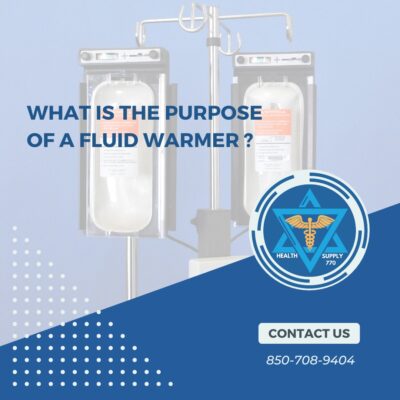What is the Purpose of a Fluid Warmer?
There are several medical devices used in the medical field. The purpose of these devices is to modernize the methods of treatment used today. These medical devices are specialized devices that help diagnose and treat diseases. Some medical devices are used to prevent certain problems. One of these devices is a fluid warmer.
A fluid warmer or blood warmer are fluid warming devices that are used to warm fluids including crystalloid, colloid, or blood products before administering to body temperature levels to prevent hypothermia in patients who are physically traumatized or are surgical. Therefore, blood and fluid warmers are highly significant devices to treat patients.
What is Hypothermia?

Signs of Hypothermia
Hypothermia is a condition that is normally caused when a person is exposed to cold temperatures for a long period. This causes the body to lose heat faster than its production the body. If a person is exposed for longer periods to cold temperatures, this results in the use of a person’s stored body energy which results in low body temperature.
This low body temperature can be dangerous for a person. A too-low body temperature affects the brain due to which the person cannot move well or becomes unable to think clearly. It is particularly dangerous because the patient will be unable to know about it happening and consequently will not be able to do anything about it. Hypothermia can also happen because of becoming chilled due to rain, sweat, or submersion in cold water.
Severe hypothermia can cause a person to become unconscious and you might not be able to detect the person’s pulse or breathing. A person suffering from hypothermia should be provided immediate medical care to prevent complications.
What is the purpose of a fluid warmer?
Fluid warmers are used for surgical and physically traumatized patients in the following ways:
Fluid warmers for surgical patients
During surgery, it is highly significant to maintain normothermia which means maintaining the normal core body temperature. If it is not maintained there is a chance that the patient will suffer from hypothermia which means a potentially dangerous drop in body temperature. Too low body temperature can be fatal and even life-threatening because it causes heart failure and failure of the respiratory system.
Therefore, warming these fluids before instilling them into open body cavities promotes blood flow and delivery of oxygen to the tissues. Also, storing IV fluids in a warming cabinet can be helpful in the maintenance of normothermia and the prevention of hypothermia.
For this purpose, it is highly important that the patients are delivered with warm fluids according to the required temperature during surgery. This ensures the maintenance of normothermia and thus helps prevent hypothermia.
This thermal balancing of the patient can be helpful in many ways as it helps lower the possibility of complications and hospital stay time.
Fluid warmers for physically traumatized patients
The administration of cold intravenous fluids can result in hypothermia in physically traumatized patients. Using warm fluids can help prevent hypothermia in these patients and prevent further complications. Infusion of warmed fluids is necessary for trauma patients to reduce thermal stress and maintain thermal homeostasis.
However, these fluid warmers can only prevent warm loss. These cannot warm already cooled patients. Therefore it is necessary to use a comprehensive approach to prevent hypothermia which includes the use of other devices. These include warmer rooms, pre-warming, and post-operation assessment of the patients.
Apart from these fluid warmers, the normal thermal balance can be promoted with the help of minimizing body exposure, layering blankets, and circulating water mattresses and garments. Head wraps can also be used to maintain the body temperature.
Also warmer rooms where the temperature is set to 70 degrees F can help reduce the risk of hypothermia. This increased temperature of the operating room can be reduced after the first hour. This increased temperature of one hour provides a drop of 1 to 3 degrees in the body temperature. The body temperature normally stabilizes after the first hour.
After the surgery, it is necessary to take care of the patients. If the patient is normothermic then blankets can help to maintain the body temperature of the patient. If the patient is hypothermic, forced-air warming helps to provide comfort to the patient and return to normal body temperature.
Categories of fluid warmers
Fluid warmers are broadly categorized into the following two types:
-
Warming cabinets
Warming cabinets are also known as warming cupboards. These warming cabinets are used by every hospital. These warming cabinets help to keep medical fluids, blood, and blankets warm at body temperature. Before inflow, fluids and solutions are warmed to body temperature to ensure the patient’s comfort and maintain normothermia. These warming cabinets are available in different sizes and design configurations. These warming cabinets consist of stainless steel interiors and are fitted with a forced air circulation system along with a digital temperature controller. These warming cabinets are suitable for warming blankets, blood bags, blood bottles, gel pads, intravenous fluids, irrigation fluids, and peritoneal dialysis (PD) fluid.
-
In-line warming
These fluid warmers help to actively warm fluids while being administered. These In-line blood warmers or In-line solution warmers are used in hospitals and clinics. These In-line warmers are used to warm refrigerated or room-temperature fluids as they are infused into the patient. These fluids can include whole blood, blood products, and intravenous or IV solutions. These warmed solutions ensure the maintenance of the patient’s core body temperature and help in the prevention of hypothermia.
How does a fluid warmer work?
Fluid warmers are specialized devices that are used in surgeries and are very helpful in preventing hypothermia. These fluid warmers are manufactured using several techniques some of which will be discussed in this article. The working of fluid warmers and their different techniques are explained below
Surface heat is used by some blood warmers which use a tubing or a cassette set that gets inserted into the device. The fluid gets heated when it passes this chamber. The blood exits the chamber heated at the specified temperature.
Another technology that is used in blood warmers is the use of an outer tube and a vessel. The fluid circulates within an outer tube and is transferred from the vessel through a tube in it before reaching the patient.
Also, the air from blanket warmers can be used as a fluid warmer. In this method, tubing is inserted into the blanket warmer’s hose in a circular pattern and blood travels through this tubing set. This blood exits by getting warm and is then used on the patient.
Conclusion
Fluid warmers are medical devices that are very useful in surgeries and for physically traumatized patients. These fluid warmers can help warm blood and other fluids before and during the surgeries to ensure normothermia. Prevention of hypothermia during surgeries is the main cause of using fluid warmers.
If these devices are not used, the patients are at a higher risk of suffering from hypothermia during or after surgery which can cause heart failure as well as a failure of the respiratory system. This hypothermia can become severe and lead to the death of the patient.
Therefore, fluid warmers are a must-have in medical settings and operating rooms to ensure that patients are given blood and other fluids warmed according to the body temperature to prevent hypothermia and consequent complications.

PhD Scholar (Pharmaceutics), MPhil (Pharmaceutics), Pharm D, B. Sc.
Uzma Zafar is a dedicated and highly motivated pharmaceutical professional currently pursuing her PhD in Pharmaceutics at the Punjab University College of Pharmacy, University of the Punjab. With a comprehensive academic and research background, Uzma has consistently excelled in her studies, securing first division throughout her educational journey.
Uzma’s passion for the pharmaceutical field is evident from her active engagement during her Doctor of Pharmacy (Pharm.D) program, where she not only mastered industrial techniques and clinical case studies but also delved into marketing strategies and management skills.


















